 Do you sell goods and services online to a foreign customer base? If so, then it’s a good idea to consider providing users with the convenience of currency conversion on your e-commerce web site.
Do you sell goods and services online to a foreign customer base? If so, then it’s a good idea to consider providing users with the convenience of currency conversion on your e-commerce web site.
Currency converting software allows your prospective customers to convert international currency prices into their home currency at the buying or checkout stage. It also lets your visitors and customers view the exact amount their card or PayPal account will be charged, expressed in their own home currency.
One benefit of providing currency conversion on your website is that it allows visitors to see and understand pricing in foreign countries in their own local currency, and makes it easier for purchasers to work out their costs and expenses.
If your site is powered by WordPress, you can add a currency conversion plugin to your WordPress site, allowing your prospective customers to easily calculate the cost of your goods.
Currencyr – WordPress Free Currency Converting Plugin
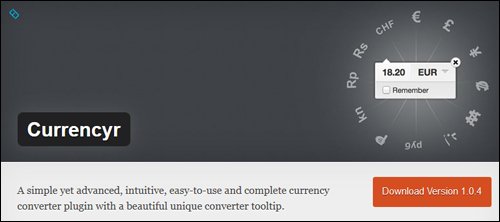
Currencyr is a simple, easy-to-use and complete currency converter WordPress plugin with a unique converter tooltip. It’s also free!
The Currencyr useful plugin features:
- In-line converter
- Supports a number of exchange rates providers, like Yahoo!, Google and European Central Bank
- WP-Cron task scheduler enabled
- Currency table and converter widget
- Supports integration with various e-store plugins such as WooCommerce, WP-eCommerce and Easy Digital Downloads.
- Can determine local currency automatically
- Translation support
Note: This plugin needs your server to be running PHP 5.3.0 or later. Do not install this plugin if you currently have an older version of PHP installed on your server. Ask your webhosting company to check and upgrade your PHP server installation.
***
You can install the plugin from your WP admin area by searching for “currencyr” in the Plugins section and clicking “Install Now” …
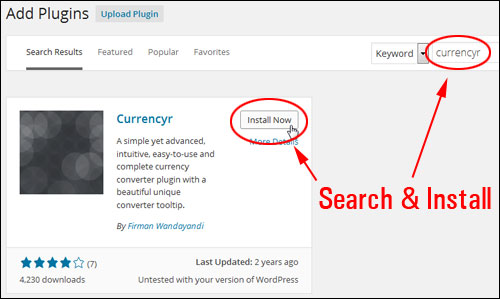
After installing and activating the plugin, you can configure the plugin’s settings by choosing Currencyr from your WordPress dashboard navigation menu …
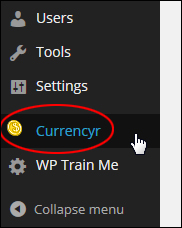
This takes you to the plugin settings area …
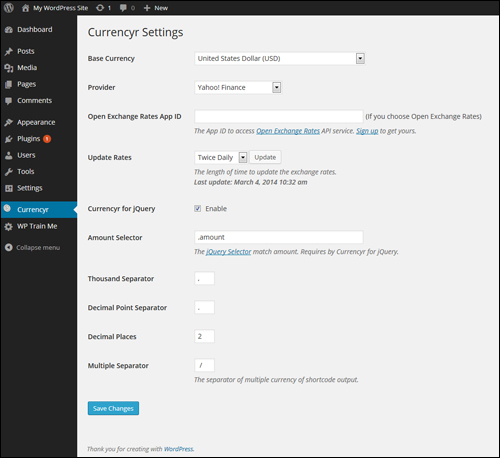
For example, you can choose a base currency from the ‘Base Currency’ drop-down menu. The default option is ’United States Dollar’ …
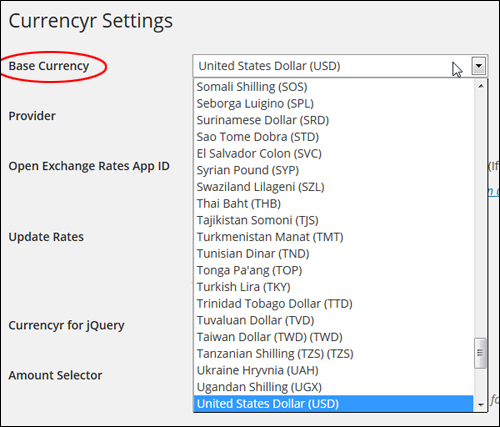
You can also specify any supported data provider from a dropdown menu. The default selection is Yahoo Finance, but you can choose another option, such as European Central Bank, FoxRate, Google Finance or Open Exchange Rates …

Note: If you choose Open Exchange Rates, an API (Application Programming Interface) will be required …

You can specify how frequently you want to update the currency exchange rates by specifying an option from the Update Rates drop-down menu …

The plugin uses jQuery, which is an open-source library of Javascript code that allows web developers to add things like animation effects to web applications (like WP plugins).
Unless there is a reason to edit the jQuery settings, you can just ignore this option …

Configure the rest of the plugin settings and click ‘Save Changes’ when you have finished configuring this section …
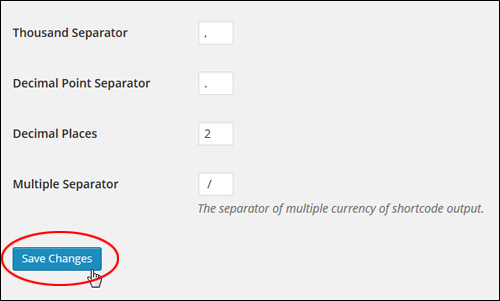
When you have configured your plugin settings, you can easily start adding currency conversion to all of your WP pages or posts using shortcodes and widgets.
Refer to the ‘Additional Plugin Notes’ section below to learn how to use currency codes (e.g. USD, NZD, ZAR, etc …) with this plugin.
How To Use Plugin Shortcodes
You can add currency conversion to posts, pages and widgets without editing your web templates using shortcodes.
Below are some examples of currency shortcodes that you can add to WP pages and posts:
Let’s say that you sell an item for a fixed amount (e.g. $175) in US Dollars (USD), and you want to display your price converted into British pounds (GBP) on your product information page.
To display this information, just insert the shortcode below to your page content …

Note: You can also add pricing in dollars and cents (for example, 89.95, 197.00, 129.10, etc …)
The example below shows how the shortcode should look once you have added it to a page …
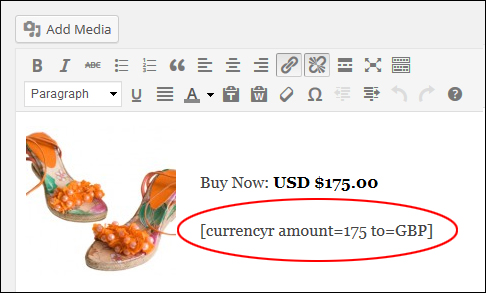
After the page or post has been published, your currency conversion will appear as you can see in the example below …
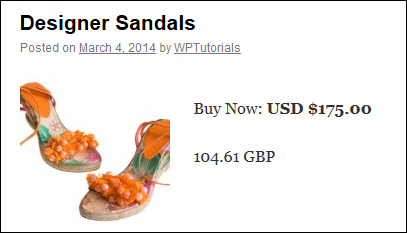
Using the same example, let’s also translate the same price into multiple currency formats.
To do this, use the shortcode below (add as many currency symbols as you want by using vertical pipes) …

The example below now shows how the above shortcode looks when inserted into a page …

Once your page has been published, the converted currency will then display as shown below …
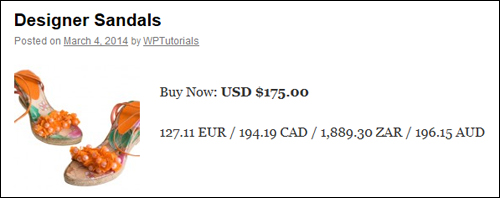
See the ‘Additional Plugin Notes’ section further below to learn how to change the currency separator symbol in the Currencyr plugin.
Now, suppose you want to specify a different base currency than the one you have set as your default.
For example, if you have set your default base currency as EUR and you have a section on your site targeted to non-European customers (like Australia or Canada), you can change the base currency using the following shortcode …

The example below shows how the above shortcode looks when inserted into your content …
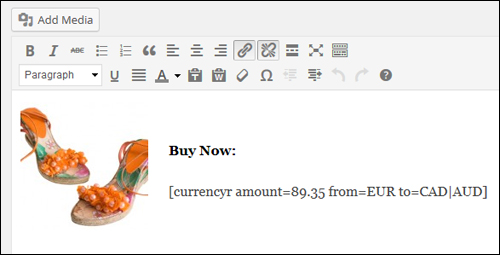
After publishing the page, the currency conversion will then appear like this …
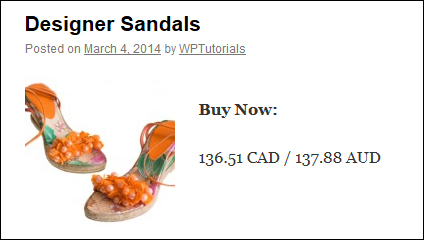
How To Use The Widget
You can also add currency conversion to your site’s sidebar using a widget.
To add the currency converter to your sidebar menu, choose Appearance > Widgets in your WordPress admin menu …
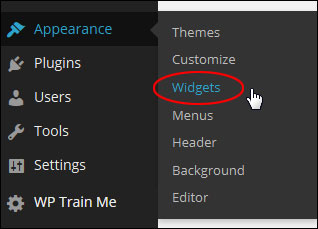
In the Widgets > Available Widgets area find the ‘Currencyr’ widget and drag it to an ‘Active Widgets’ location …
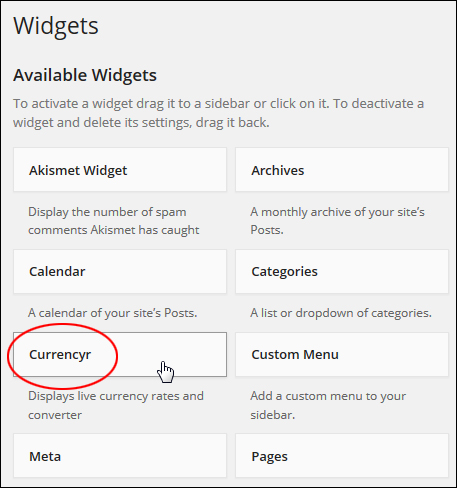
Configure the widget options as shown below (add the currency codes you would like displaying on your widget separated by a comma), and click ‘Save’ to update your settings …
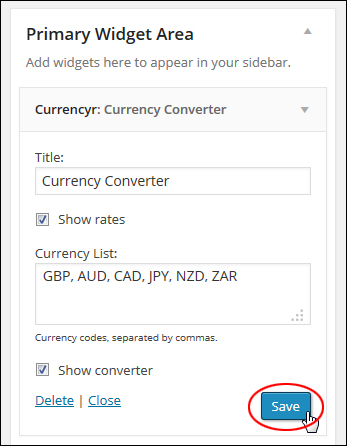
The currency converter tool will now display on your site’s sidebar menu with the options you have specified when configuring the widget …
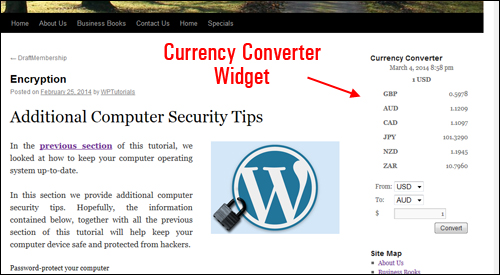
Additional Plugin Notes
This section contains additional information about using the Currencyr plugin.
Currency Separator
The Currencyr plugin allows you to specify a symbol of your choice to display as the currency separator when using several currencies.
You can select a different symbol in the Multiple Separator settings field.
So, for example, entering the default symbol “/” (forward slash) …

Displays your currency values separated by the forward slash as you can see in the screenshot below …
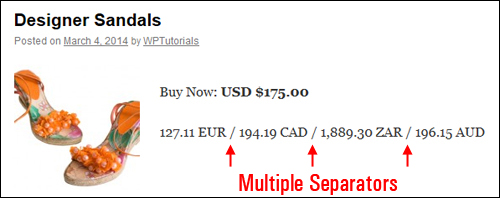
If you modify the symbol and update your plugin settings …

Your site visitors will see the new symbol display as the currency separator …
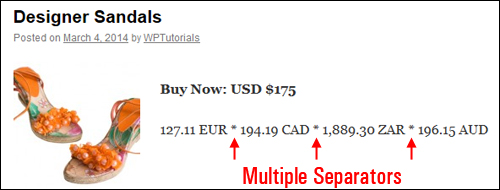
Integration With e-Commerce Platforms
As stated earlier, the Currencyr plugin integrates with various WP-compatible e-commerce plugins like WooCommerce, WP-eCommerce, Shopp, and Easy Digital Downloads …
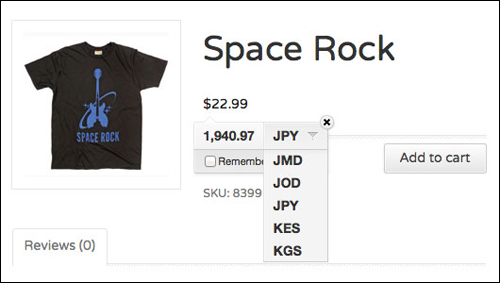
(image source: plugin site)
And there you have it! Now you know how to easily add a currency converter to your WordPress web site.
To learn more about WordPress e-commerce plugins, see the tutorial below:
***
"Learning WordPress has been a huge stumbling block for me. I've been looking for something that covers absolutely everything but doesn't cost an arm and a leg. Thank you so much ... you have just provided me with what I have been looking for! Truly appreciated!" - Tanya

